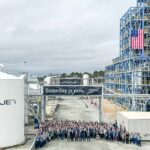United Airlines, the world’s third-biggest carrier by flight frequencies, expects to use 10 million gallons of sustainable aviation fuel this year, triple its 2022 volumes, following new agreements to introduce blended product at San Francisco International and London Heathrow airports. It already uses SAF at Los Angeles and Amsterdam, and has invested in the future production of more than 5 billion gallons through both offtake agreements and equity stakes in emerging SAF producers. The airline has just uplifted its first blended SAF from San Francisco and will add London later in the year when supplies become available there. United has also announced the addition of eight new partners to its Eco-Skies Alliance programme, through which corporations contribute to the airline’s SAF purchases to help offset the emissions of flights by their own employees. The latest sign-ups take to 24 the number of corporations participating in the programme, an increase of 50%.
The use of SAF is a key pillar in United’s programme to achieve net zero carbon emissions by 2050 without the use of conventional carbon offsets, it says, which the airline’s CEO, Scott Kirby, has criticised as irrelevant to reducing flight emissions. It claims to have been the first airline to commit to net zero 2050 without relying on offsets.
Through investment vehicles established to support companies and technologies which can help to decarbonise air travel, United has also bought into emerging manufacturers of electric, hybrid-electric and hydrogen-electric propulsion systems, announced provisional orders for zero-emission powertrains, commuter planes and air taxis, and purchased a stake in Natron Energy, a company which produces high-density, fast-charging batteries to power electric vehicles and equipment at airports.
“In just a few years United has exponentially increased its SAF use,” said Lauren Riley, the company’s Chief Sustainability Officer. “While 10 million gallons of SAF in 2023 represents a fraction of what we need, we have also made big investments in producers that are using everything, from ethanol to algae, to CO2, to help increase our available future supply. We believe these investments, along with our continued collaboration with policymakers, cross-industry businesses and other airlines, will help us scale this brand-new industry to achieve comparable success to solar and wind.”
The airline’s SAF use in 2023 is expected to be three times last year’s total, and 10 times the uptake in 2019. Last month, as part of its increase in SAF use, United received 1.5 million gallons at San Francisco International from European renewable fuel company Neste, which also supplies the airline in Amsterdam. That fuel is manufactured using renewable waste and residue raw materials including used cooking oil and animal fat waste.
United will begin using SAF at Heathrow later this year, the first time the airline has participated in the airport’s SAF incentive programme. After delivering its first SAF to airlines in June 2021, Heathrow introduced the incentive scheme last year, through which it covers up to 50% of the extra cost of SAF to encourage demand from airlines. Last year, it achieved its target of 0.5% blended SAF use and this year it is aiming for 1.5%. By 2030, Heathrow wants SAF to comprise 11% of the aircraft fuel used at the airport, rising to at least 80% by 2050 and potentially 100% if sufficient supplies are available of synthetic aviation fuels, or e-fuels.
The SAF used by United is part-funded by the proceeds of its Eco-Skies Alliance programme, which was launched in April 2021 as both a SAF financing mechanism and an effective option for corporations to help compensate for their air travel emissions. United said since the programme’s inception, it had contributed to the airline’s purchase of almost 15 million gallons of SAF, 50% more than the 10 million gallons it expects to consume this year. The programme now has 24 participants, including eight new joiners just announced by the airline – Audi, Bank of America, Cisco, Corporate Travel Management, DB Schenker, First Eagle Investments, Macquarie Group and Thermo Fisher Scientific.
But while United continues to invest in both SAF and its producers, its newly-signed commercial partner, Dubai-based Emirates, has expressed doubts that there will be sufficient SAF available to power long-haul flights, which account for most of its operations. This week, at the Arabian Travel Market, a major trade show staged in Dubai, the airline’s CEO, Sir Tim Clark, said fossil fuels would, “for the time being”, remain the dominant energy source for long-haul flights.
In answer to media questions about aviation’s efforts to decarbonise, Clark said there was insufficient funding to produce affordable or sufficient volumes of SAF, echoing continuing global concerns about the continuing high cost of the fuel. “The notion that sustainable aviation fuel is going to crack this terrible nut in the next few years is going to be a very difficult one to answer,” he replied. “We’ve got the tech to do it, but globally the funding is not there to industrialise.”
His comments follow the test flight in January from Dubai of an Emirates Boeing 777 with one of its two GE90 engines powered by 100% SAF, as part of a proof-of-concept demonstration performed in partnership with Boeing, GE Aerospace, Honeywell and two renewable fuel companies, Neste and Virent (see article). The event was described as a key initiative of the ‘Year of Sustainability’ declared by the United Arab Emirates, ahead of Dubai’s hosting later this year COP28 and ICAO’s third Conference on Aviation and Alternative Fuels (CAAF/3).
Photo: United Airlines














More News & Features
Swiss advanced SAF technology startups Metafuels and Synhelion reach project milestones
PtX fuels have significant Asia-Pacific potential but face many barriers, finds report
Airfreight giants DHL Express and FedEx announce big US SAF deals
Asia-Pacific study reveals pessimistic outlook for SAF uptake by 2030 as Singapore details levy
Supply shortage means airlines have no chance of meeting a 10% SAF by 2030 target, says IATA chief
EU states to mobilise 500 million euro support for early-mover eSAF production startups